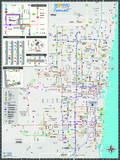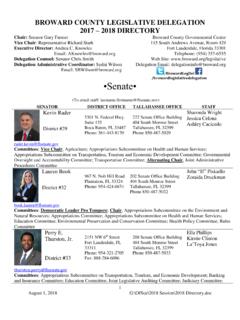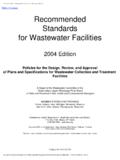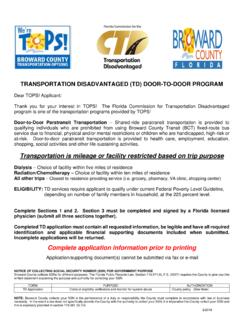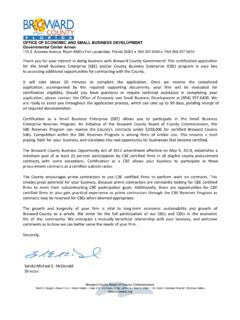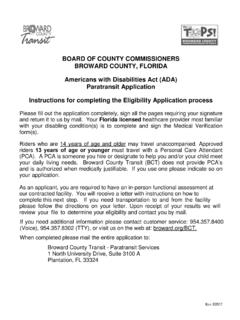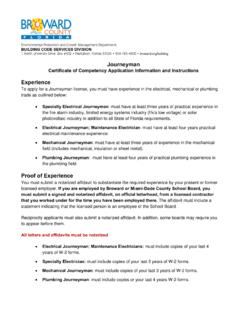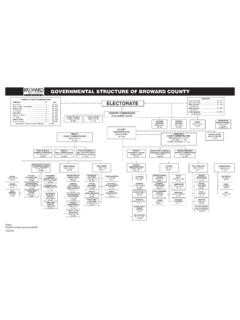Transcription of Equivalent Residential Unit Factors
1 Public Works Department Water & Wastewater Services WATER & WASTEWATER ENGINEERING DIVISION 2555 West Copans Road Pompano Beach, Florida 33369 954-831-0745 FAX 954-831-0798/0925 Equivalent Residential UNIT Factors Date: April 2, 2012 Date Last Issued: October 1, 2011 Date First Issued: 1996 Broward County Water and Wastewater Services (WWS) uses Equivalent Residential Unit (ERU) Factors for sizing water meters and determining certain fees and charges. By definition, one ERU equals a single family residence with a standard (5/8") meter. The following Equivalent Residential UNIT FACTOR SCHEDULE lists ERU Factors in terms of ERU per Unit for common types of use.
2 To determine the ERU per Unit factor, locate the Type of Use in the table and note the Unit of Measure and ERU per Unit. For example, The Type of Use of Condominium/ Apartment is ERU each and Merchandising is ERU per 1000 SF (square feet of gross building area). Equivalent Residential UNIT FACTOR SCHEDULE TYPE OF USE UNIT OF MEASURE ERU per UNIT REF. CODE Equivalent Residential Unit ---- ---- Single Family House ( 5/8" meter ) each R01 Single Family House ( larger than 5/8" meter ) each R02 Condominium/Apartment each R03 Mobile Home lot R04 Vehicular Repair 1000 SF C01 Gas Station ( fueling only ) fuel pump C02 Laundry and/or Dry Cleaning (staff operated machines) no longer a part of the schedule C03 Laundry (coin operated machines) 1000 SF C04 Merchandising 1000 SF C05 TYPE OF USE UNIT OF MEASURE ERU per UNIT REF.
3 CODE Warehouse (mixed use) 1000 SF C06 Warehouse (homogenous, bulk storage use) 1000 SF C07 Self-Service Storage 1000 SF C08 Restaurant 1000 SF C09 Fast Food Service 1000 SF C10 Bar, Cocktail Lounge no longer a part of the schedule C11 Office 1000 SF C12 Day Child Care 1000 SF C13 Place of Worship 1000 SF C14 School student C15 Hotel (with restaurant and/or meeting rooms) has been replaced by C19 C16 Hotel (without restaurant and meeting rooms) has been replaced by C19 C17 Movie Theater no longer a part of the schedule C18 Hotel rental room C19 Single Family Lot Irrigation lot I01 Landscape and Lawn Irrigation (under 20 acres) 1000 SF less credit I02 Road ROW Irrigation 1000 SF I03 Most of the data for the Schedule was obtained in 2011 by determining the water usage characteristics for actual WWS customers for July 2009 through June 2010.
4 The 2011 study included 21,894 apartments and condominiums; 4,493 mobile homes; 43,000 square feet of laundries; 819,000 square feet of merchandising; 3,865,000 square feet of warehousing; 710,000 square feet of self-service storage; 5,579,000 square feet of office space; 25,808 school students; 2,228 hotel rooms; and 952,000 square feet of landscape and lawn irrigation. In total, the 2011 study considered commercial customers with a total potable water consumption of 1,083,000 gallons per day, non-single family Residential customers with a total potable water consumption of 3,494,000 gallons per day and irrigation with a total potable water consumption of 166,000 gallons per day.
5 The raw data used in the study contained a range of data points. To mitigate a small number of low or high data points skewing the result, WWED used the average of the 10th percentile through 90th percentile gallons per day per unit data points to calculate the values in the Schedule. Even so, the middle range of data used to calculate the ERU factor routinely had low values lower than 70% of the average and high values higher that 130% of the average. ERUs are determined based on design capacity. For example, a partially completed office building would be based upon the total square feet under roof, not the square feet of finished space.
6 The Schedule does not cover all possible Types of Use. For each Type of Use listed on the Schedule, the ERU per Unit for that Type of Use applies. If the Schedule does not list a Type of Use, the Water and Wastewater Engineering Division (WWED) will first determine if the Schedule lists a sufficiently similar Type of Use. For example, a retirement home is sufficiently similar to an apartment to utilize the apartment ERU factor for that retirement home. In the case where a sufficiently similar Type of Use cannot be identified, WWED may elect to perform a usage study of existing customers.
7 For the usage study, ERUs for the subject Type of Use will be based upon the conversion of one ERU equal to 185 gallons per day average water demand, or one ERU equal to 246 gallons per day maximum day water demand. Whichever calculation results in the greater number of ERUs, as measured at the point of service, will become the value used to determine the water meter size and to calculate fees and other charges. WWED may require the potential customer to supply data for the usage study which should include three years of good potable water consumption information for at least 7 but no more than 20 similar locations.
8 WWED will use the 10th percentile through 90th percentile gallons per day per unit data points in its analysis. For Types of Use that utilize water, wastewater ERUs are based on water consumption so the number of water and wastewater ERUs are the same value. For Types of Use that do not utilize water but generate sewage, one ERU equals 147 gallons per day average sewage generated as measured at the point of service. On occasion, a WWS non- Residential customer may want to connect a structure(s) to the wastewater system that has been historically served by the water system. In this case, WWED will use the most current three years of actual water usage records for the structure(s) to determine the wastewater ERUs if the following conditions exist: - The water records indicate continuous, consistent usage of water; - No other water source is used on the property, except for irrigation; and - The customer provides a signed statement that: (a) The structures have been consistently occupied over the last three years; (b) The type of use has not varied over the last three years; and (c) The type of use will not change in the foreseeable future.
9 This approach to calculate wastewater ERUs will only apply for structures that have been connected to the water system and are located on the same property. Similar structures on the same property that are not connected to the water system do not qualify for this approach. ERU credit will be given when a proposed Type of Use replaces an existing Type of Use. The amount of the credit may not exceed the ERU charge for the proposed Type of Use. For example, if mixed use warehouse space was to be converted to office, credit for the warehouse space ERU would be applied to the office ERU.
10 Credits are determined using the Schedule. ERUs stay with the property referenced in the Broward County Utility Connection Permit or developer's agreement. They are not transferrable between two different properties, even if the properties are owned by the same entity. Unused ERUs can or cannot, at the option of the seller, transfer from one owner to another in conjunction with a sale of property. If the seller does transfer unused ERUs with a property sale, documentation will be required in order for the new property owner to receive credit for the unused ERUs. The documentation must come from the seller, include a legal description and description drawing of the property associated with the transfer of ERUs, and clearly indicate the number of ERUs transferred with the sale.
